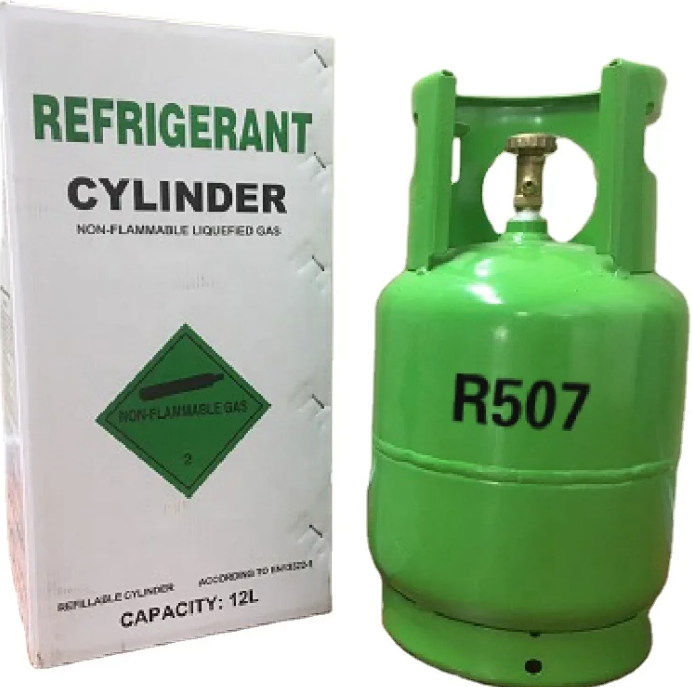What Is R507 Refrigerant ?
507 is a refrigerant widely used in refrigeration systems, commonly known as pentafluoroethane and trifluoromethane. This mixed refrigerant has efficient heat transfer performance and lower evaporation pressure, making it widely used in commercial refrigeration, industrial refrigeration, and home air conditioning. 507 is a mixture composed of two different components that can dissolve each other in both gaseous and liquid states, and can transfer heat evenly in evaporators and compressors. The advantage of this refrigerant is that it has good fluidity and heat exchange performance, while also reducing the noise and vibration of the refrigeration system. In addition, 507 has relatively less environmental damage because it does not contain chlorine atoms and does not cause depletion of the ozone layer. However, 507 also has some drawbacks, such as its poor fluidity at low temperatures, which may affect the efficiency of refrigeration systems. In addition, the cost of 507 is relatively high, and its recovery and reuse are difficult, so special attention should be paid to environmental and safety issues during use. Overall, 507 is an efficient and environmentally friendly refrigerant suitable for various refrigeration systems. However, in order to protect the environment and resources, we should use and recycle 507 reasonably to reduce its impact on the

Working principle of 507: 507 is a mixed refrigerant composed of pentafluoroethane (R12) and trifluoromethane (R134a). This refrigerant works in air conditioning and refrigeration systems by:
Compression process: 507 is sucked into the compressor, where it is compressed into high-pressure gas.
Condensation process: High pressure gas cools in the condenser, releases heat, and converts into liquid.
Expansion process: Liquid expands in the expansion valve, causing pressure and temperature to decrease and become gaseous.
Evaporation process: Gaseous absorbs heat in the evaporator, converts it into a low-temperature gas, and cools the surrounding environment. During this process, 507 continuously circulates and achieves refrigeration or heating functions through its thermodynamic properties. However, it should be noted that 507 has a destructive effect on the ozone layer, so modern refrigeration systems have gradually shifted towards using more environmentally
Working principle of 507: 507 is a mixed refrigerant composed of pentafluoroethane (R12) and trifluoromethane (R134a). This refrigerant works in air conditioning and refrigeration systems by:
Compression process: 507 is sucked into the compressor, where it is compressed into high-pressure gas.
Condensation process: High pressure gas cools in the condenser, releases heat, and converts into liquid.
Expansion process: Liquid expands in the expansion valve, causing pressure and temperature to decrease and become gaseous.
507 (R-507) is a commonly used HFC (hydrofluorocarbon) refrigerant, composed of a mixture of R-125 (pentafluoroethane) and R-143a (trifluoromethane), used to replace CFC (chlorofluorocarbons) refrigerants that were previously harmful to the ozone layer. The following is a summary of the advantages and disadvantages of 507:
Advantages:
Environmental friendliness: Compared with CFCs, HFCs such as R-507 have a smaller ozone layer destruction effect and meet current environmental requirements.
High efficiency: R-507 has high heat transfer efficiency and cooling capacity, making it excellent in refrigeration systems.
Compatibility: R-507 can be used in many existing CFC and HCFC refrigeration systems without the need for extensive equipment modifications.
Stability and safety: R-507 exhibits good chemical and thermal stability under normal working conditions, is not easily decomposed, and is not flammable.
Disadvantages:
Greenhouse effect: Although R-507 has a small impact on the ozone layer, it still has a high global warming potential (GWP) and has an impact on global climate change.
Cost: Compared to some other refrigerants, the cost of R-507 may be higher, which may increase the operating costs for users.
Recycling and reuse: Due to the high GWP of R-507, its recycling and reuse have become more important, but this also increases the complexity and cost of operations.
Regulatory restrictions: With increasing attention to environmental impacts, some countries and regions have begun to restrict or prohibit the use of HFCs with higher GWP, which may affect the future use of R-507.
In summary, 507 is a refrigerant with excellent performance, but its environmental impact and high cost have led people to constantly seek more environmentally friendly and economical choices. With the advancement of technology and changes in environmental regulations, there may be more refrigerants that can replace R-507 in the future.